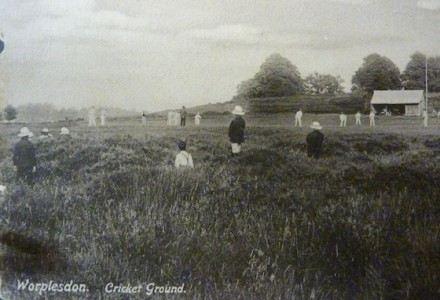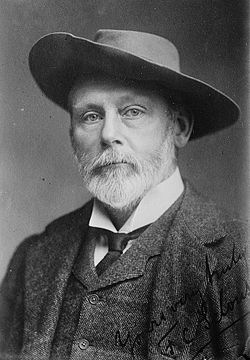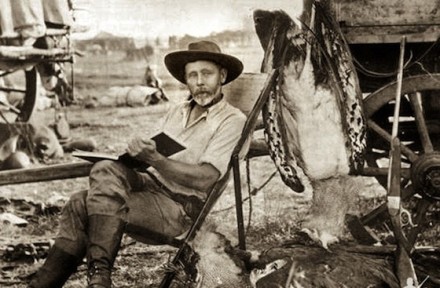- Stay Connected
 Abraham Lincoln
If given the truth, the people can be depended upon to meet any national crisis...
Abraham Lincoln
If given the truth, the people can be depended upon to meet any national crisis...
 Guildford news...
for Guildford people, brought to you by Guildford reporters - Guildford's own news service
Guildford news...
for Guildford people, brought to you by Guildford reporters - Guildford's own news service
Incredible Big Game Hunter Who Lived at Worplesdon
Published on: 20 Mar, 2012
Updated on: 15 May, 2024
by David Rose
One of the most revered big game hunters ever, who was dubbed “a gentleman officer and epic wild man,” made his home in Worplesdon.
Frederick Courteney Selous (pronounced ‘sir loo’) was born in London in 1851 into an aristocratic family. But from a young age all he wanted to do was to travel the world in pursuit of wild animals.
In fact, Selous was one of the first conservationists. It is said that in none of his expeditions was his object the “taking of a big bag”. He was a hunter-naturalist. But as a slayer of great game in the late 19th century, he was ranked with the most famous of the world’s sportsmen.
He really did love wildlife – not only animals, but insects, birds, and so on. In time Selous became aware that the sport enjoyed by European hunters was leading to a significant reduction in the amount of game available in Africa.
He first went to South Africa when he was 19, and was granted permission by the King of the Ndebele to shoot game anywhere in his dominions.
Selous hunted and explored all over the Transvaal and south of the Congo Basin. He shot elephants and collected specimens of all kinds for museums and private collections.
At the request of Cecil Rhodes in 1890, Selous was employed by the British South African Company as a guide to a pioneer expedition to Mashonaland.
In 1894, aged 42, he married 20-year-old Marie Catherine Gladys Maddy. They settled in a house called Heatherside on the edge of Worplesdon at Fox Corner. They had two sons, Frederick Hatherley Bruce Selous, and Harold Sherborn Selous.
At Heatherside he had built a special gallery to house his trophies from his shooting expeditions.
Selous was a remarkable man. It is said that he had wonderful eyes, “as clear and as blue as the summer sea”. And that “he had a presence that was apt to make other people look insignificant. He was adored by all his friends, and even perfect strangers seemed to come under his magnetism at the first introduction”.
He would have been a well known character in Worplesdon. He was something of a fitness fanatic, thinking nothing of going on 100 mile cycle rides. Not surprisingly, he excelled at many sports. His great love was cricket and he played for the Worplesdon team.
There are some fascinating snippets relating to Selous and his time at Worplesdon in his friend John Guille Millias’s biography of the great man, Frederick Courtenay Selous DSC Captain 25th Royal Fusiliers, (published in 1919).
For example: “The original house [Heatherside] was not large, but possessed a good area of land, flanked by a pretty and clear stream, and this plot was eventually made into a charming garden which Mrs Selous has devoted care and energy to render beautiful and homelike. In latter years a good orchard was added. The house was greatly added to and improved in 1899. At the same time as the house was being built a museum was erected close by, and in this all Selous’ treasures, were stored.”

The residence formerly known as Heatherside in Worplesdon which Selous and his wife made their home in the 1890s.
“He liked nearly all outdoor sports at different times. He played an energetic game of tennis and was a really good croquet-player. Most of all he loved cricket, and played regularly for his local club at Worplesdon, taking part in all their matches until 1915. At Worplesdon he put so much life into the club that they were soon able to leave the former rough ground where former matches were played and take and keep in order an excellent cricket-field. I played in some of these matches, which were rather of the ‘Dingly-Dell’ type, and it was always a treat to see Fred standing so close ‘in’ at ‘point’ that he looked as if he would catch the batsman before he hit the ball. ‘Big Game Hunters v Worplesdon’ was always a great and solemn occasion. In later years he was a most indefatigable cyclist, and thought nothing of riding over to see his friends thirty and forty miles away, and back, even when he was over sixty years of age. When at home he never rode in a car if he could avoid it, as his policy was ever to keep fit by physical exercise.”

Picture postcard view of the original cricket pitch at Worplesdon in the early 1900s. Selous may be one of those playing!
Selous returned to Africa to take part in the First Matabele War in 1893, and was wounded during the advance on Bulawayo. During this episode of his life he fought alongside Major Robert Baden-Powell.
When the First World War broke out, Selous appears to have been spending time as a special constable in Pirbright! He was keen to do his bit for king and country, but to begin with could not get himself enlisted – probably something to do with his age, as he was by that time over 60 years old.
Finally, in 1915, he joined the British Army as a captain in the rather uniquely composed 25th (Frontiersmen) Battalion, Royal Fusiliers. His theatre of war was East Africa, and on September 26, 1916, he was awarded the Distinguished Service Order (DSO).
However, he did not live to see the war’s end. This great marksman was shot in the head by a German sniper on January 4, 1917, on the banks of the Rufiji River, and died instantly. He is buried near to where he fell in today’s Selous Game Reserve, Tanzania. His grave is marked by a simple flat stone with a brass plaque.
Many of the Selous trophies have gone into museums and natural-history collections. The Natural History Museum’s Selous Collection in London has 524 mammals from three continents, all shot by him. It includes 19 African lions.
His widow continued to live in Worplesdon and died in 1951. His son, Frederick Hatherley Bruce Selous MC, was a pilot with the Royal Flying Corps. He was killed in France in 1918.
In researching this story I enlisted the help of fellow local historian Ron Sims. It took us some time to locate Selous’ Worplesdon house Heatherside. It is now divided into two properties under other names. Ron then realised that he had visited the property many years ago when he worked for a demolition firm soon after leaving school. The firm was employed in demolishing what he believes must have been Selous’ museum. He recalls it as being a long single-story building and that when he first went in it there was a very large painting still hanging on the wall. He can’t remember what the painting was of, only that it had a very ornate frame. I wonder where that ended up?



















Gordon Bridger
April 2, 2012 at 7:32 pm
David. Did you know that Selous was member of the Guildford Institute and gave several of his trophies and books to it? His antler horns hung in the billiard room. When sorting out the GI we gave them, I think, to the Natural History Museum – Mathew Alexander was involved.
David Rose
April 2, 2012 at 8:07 pm
Thanks Gordon, I did not know that. I am only just beginning to find out what an incredible man Selous was. The details you have given me are very interesting. I am sure there is a lot more to discover about him and his connections with Guildford and Worplesdon. Let’s hope more details come to light soon.
Terry Cater
April 5, 2012 at 11:58 am
David
Did you know that at the age of 60 years Selous joined Mr Roosevelt, the then U. S. President, in a big game hunting expedition and at a later date received a visit from Roosevelt at his home at Worplesdon.
Also whilst playing cricket for Worplesdon C. C. he was made Captain of the 1st X1 in 1910 and was Club President from 1910-1913.
Regards Terry
David Rose
April 5, 2012 at 12:14 pm
Thanks Terry for the additional details.
I knew Selous and Roosevelt were good friends, but didn’t know he visited the ‘big game hunter’ at his Worplesdon home.
And thanks for noting he was also club president of Worplesdon Cricket Club.
All these details are most useful is adding to the story of Selous and his local connections.